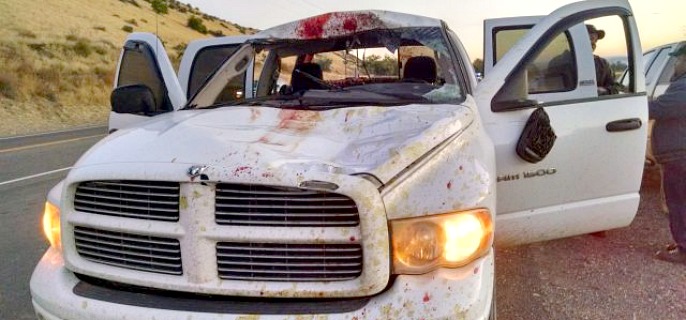
PHOTO COURTESY OF OSP
Within the last few days there have been several wildlife-involved traffic collisions on Oregon highways, serving as another reminder for travelers to be on extra alert for wildlife and other animals on the road.
On Thursday, Oct. 9 at approximately 5:45 a.m., a Dodge Ram pickup driven by Eric Meyerhofer, 44, of Payette, Idaho, was southbound on Highway 201N near milepost 22 north of Ontario in Malheur County when a deer entered the roadway. Meyerhofer wasn’t able to avoid the deer, striking it with the front of the pickup. The deer broke through the pickup’s windshield and came to rest dead on the front passenger seat.
Fortunately there were no passengers in the pickup. Meyerhofer received glass-related cuts but declined medical transport. A photograph from the incident is provided with this release.
In another incident on Thursday, two elderly people were transported with injuries after crashing while avoiding a deer on the road in Baker County. The crash involved a Subaru Legacy driven by Beverly Thompson, 76, from Richland, Wash., who was eastbound on Highway 86 near milepost 35 when the driver served to miss a deer. The vehicle crossed the westbound lanes and off the highway where it went up an embankment, striking a tree and rolling down the embankment where it came to rest on its top.
Passenger William Thompson, 82, of Richland, was able to get out of the vehicle. His wife was extricated by responding EMS personnel. Both were transported by air ambulance to an unidentified hospital for treatment of injuries.
According to ODOT, over the past 10 years more than a third of the total reported vehicle-wildlife crashes occurred September – November. During this season, OSP, ODOT and Oregon Department of Fish & Wildlife (ODFW) urge drivers to be aware of the possible dangers associated with animals on or near our highways. Extra vigilance is required. The following information may help reduce these incidents:
• The annual deer rut season typically lasts from late October to mid-to-late November, increasing deer activity in and around roadways.
• During the next few months there will be fewer daylight hours and visibility will be challenged by darkness and winter weather conditions.
• Be attentive at all times, but especially sunset to sunrise.
• When driving in areas that have special signs indicating the possible presence of animals/wildlife, please use extra caution because these signs are posted for a reason.
• Be extra careful in areas where there is a lot of vegetation next to the road or while going around curves. Wildlife near the road may not be visible.
• Remember that the presence of any type of animal/wildlife could also mean that others are nearby.
• When you see an animal/wildlife near or on the roadway, reduce your speed and try to stay in your lane. Many serious crashes are the result of drivers swerving to avoid wildlife or other obstacles and they crash into another vehicle or lose control of their own vehicle.
• The same advice applies for smaller wildlife like nutria or raccoons – try to stay in your lane and do not swerve for these animals. They are less dangerous to vehicles than big game animals; losing control of your vehicle is a larger concern.
• Always wear your safety belt, as even the slightest collision could result in serious injuries.








